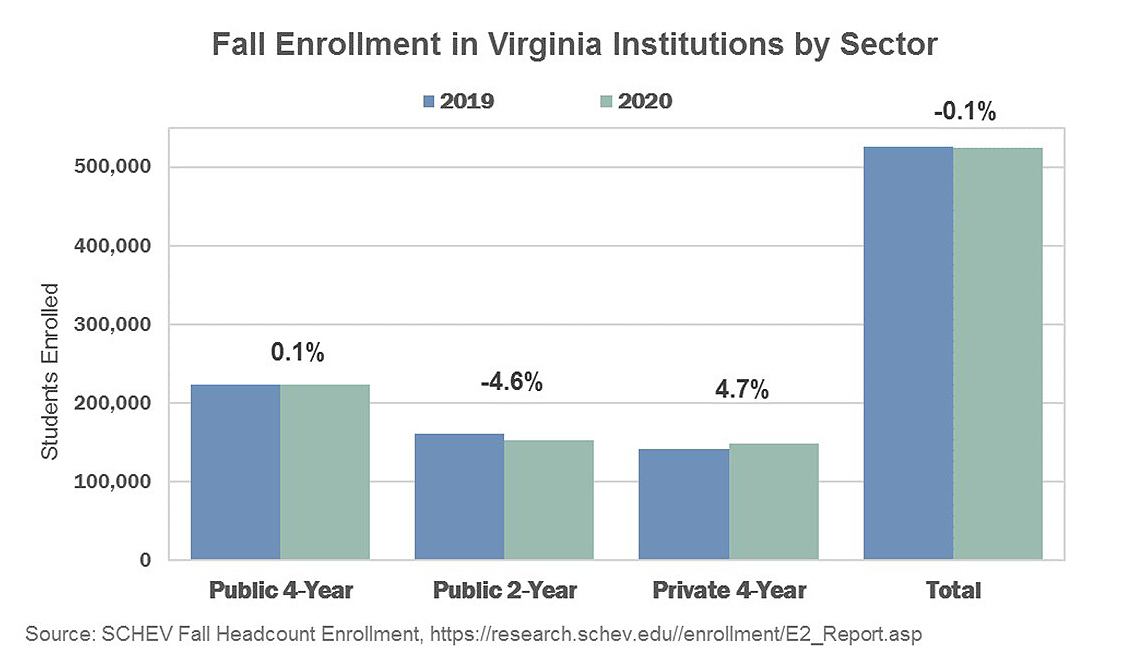For immediate release
RICHMOND — The State Council of Higher Education for Virginia (SCHEV) released analysis of fall enrollment at Virginia college and universities, an update to the Early Enrollment Estimates published last fall. This post reflects new insights based on the final fall enrollment report which showed that fewer new students enrolled in college for the first time and in two-year programs. African American/Black and Hispanic student enrollment also declined, though comparable to white students.
The analysis also shows that overall enrollment at Virginia higher ed institutions remained at similar levels in Fall 2020 compared to the previous year, despite the COVID-19 pandemic that disrupted campus operations. This bucks nationwide trends, where enrollment decreased 2.5% according to the National Student Clearinghouse. While this relative stability is promising, there also are warning signs of widening inequality and long-term impacts in the data.
Variations by Sector & Institution
Virginia’s community colleges saw steep declines of nearly 5% over 7,000 students. Its enrollment of 153,075 is the lowest since 2002. SCHEV’s strategic finance plan found that Virginia needs to award more sub-baccalaureate degrees and certificates to meet workforce demands, so it’s concerning to see the public two-year sector, the colleges that offer those programs, with the largest decrease. These counts only include students seeking for-credit degrees and certificates, and not the non-credited credentialing programs.
Overall, enrollment in the public four-year sector remained stable. Eight of Virginia's four-year public institutions lost students, however, the other seven grew their enrollment. George Mason University grew by the most students (777), while Radford University lost the most students (1,175). This decline at Radford was largely due to the wind down of a teacher competency-based education program, and not traditional undergraduates. The private four-year sector actually saw an increase of nearly 5%, although growth was largely attributed to out-of-state students attending Liberty University.

Said Tom Allison, SCHEV’s senior associate for finance policy & innovation and the post's author, “The uncertainty the pandemic sowed might have influenced some students to “hit pause” on starting any new academic plans; that’s why the levels of returning students remained stable and new students declined. We know the pandemic also exposed existing inequalities in our society and economy; professionals who could stay at home did not see any changes to their income, while households employed in the hospitality, food and other service industries lost jobs. This could explain the decline in institutions that serve these students, such as the community colleges.”
###
All Insight posts are available at https://schev.edu/index/reports/insights.
The State Council of Higher Education for Virginia is the state’s coordinating agency for higher education. With Pathways to Opportunity: The Virginia Plan for Higher Education, SCHEV is dedicated to making Virginia the best state for education by 2030. For more on this statewide strategic plan, visit schev.edu/TheVirginiaPlan.
Welcome to Insights, SCHEV's platform to interpret and communicate data and policy with the overall goal of informing policy-making, engaging institutions and drawing attention to these resources. Centered around SCHEV's nationally leading data collection, each Insight will visualize complex ideas and help inform funding and policy decisions.
